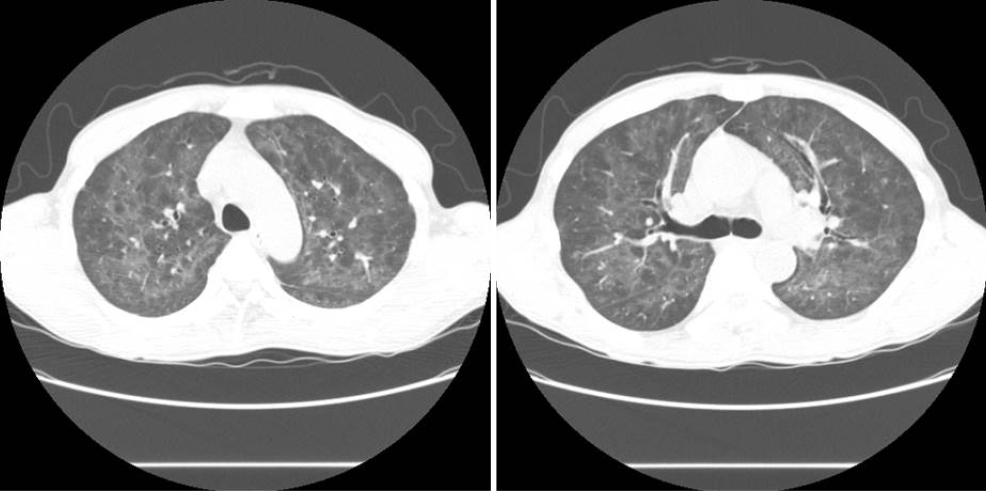Lab Med Online.
2016 Oct;6(4):250-254. 10.3343/lmo.2016.6.4.250.
A Case of Pneumonia Caused by Pneumocystis jirovecii Resistant to Trimethoprim/Sulfamethoxazole in the Absence of Previous Drug Exposure
- Affiliations
-
- 1Department of Laboratory Medicine, Asan Medical Center and University of Ulsan College of Medicine, Seoul, Korea. sung@amc.seoul.kr azacsss@naver.com
- KMID: 2353428
- DOI: http://doi.org/10.3343/lmo.2016.6.4.250
Abstract
- Pneumocystis jirovecii pneumonia is a common opportunistic infection seen in patients with human immunodeficiency virus (HIV) infection. Dihydropteroate synthase (DHPS) is a target of sulfa drugs, and mutations in DHPS gene are associated with failure in treatment and prophylaxis of P. jirovecii infections in HIV-infected patients. Here, we report a case of a patient with P. jirovecii infection, harboring DHPS gene mutations, who had not been previously treated with trimethoprim/sulfamethoxazole (TMP/SMX). A 50-yr-old man was admitted to the hospital with symptoms such as fever, cough, sputum, and sore throat. Chest computed tomography scanning revealed diffuse ground glass opacity in both the lungs, and the patient was diagnosed as having HIV infection with a CD4+ T cell count of 22/µL. Immunohistochemical test results were positive for P. jirovecii. He was treated with TMP/SMX; however, his symptoms and laboratory findings did not improve. The treatment was changed to clindamycin and primaquine, and his symptoms improved after 3 days. Molecular testing of the sample for the detection of DHPS gene mutations and the typing of mitochondrial large subunit rRNA (mtlsurRNA) revealed DHPS gene mutations at codon 55 and 57, respectively, and the case had type 3 mtlsurRNA. This case study illustrates that DHPS mutation test results can be positive even in patients without previous exposure to TMP/SMX.
MeSH Terms
Figure
Reference
-
1. Edman JC, Kovacs JA, Masur H, Santi DV, Elwood HJ, Sogin ML. Ribosomal RNA sequence shows Pneumocystis carinii to be a member of the fungi. Nature. 1988; 334:519–522.
Article2. Stringer JR, Beard CB, Miller RF, Wakefield AE. A new name (Pneumocystis jiroveci) for Pneumocystis from humans. Emerg Infect Dis. 2002; 8:891–896.3. Kaplan JE, Benson C, Holmes KK, Brooks JT, Pau A, Masur H, et al. Guidelines for prevention and treatment of opportunistic infections in HIV-infected adults and adolescents: recommendations from CDC, the National Institutes of Health, and the HIV Medicine Association of the Infectious Diseases Society of America. MMWR Recomm Rep. 2009; 58:1–207. quiz CE1-4.
Article4. Lane BR, Ast JC, Hossler PA, Mindell DP, Bartlett MS, Smith JW, et al. Dihydropteroate synthase polymorphisms in Pneumocystis carinii. J Infect Dis. 1997; 175:482–485.5. Volpe F, Dyer M, Scaife JG, Darby G, Stammers DK, Delves CJ. The multifunctional folic acid synthesis fas gene of Pneumocystis carinii appears to encode dihydropteroate synthase and hydroxymethyldihydropterin pyrophosphokinase. Gene. 1992; 112:213–218.
Article6. Walker DJ, Meshnick SR. Drug resistance in Pneumocystis carinii: an emerging problem. Drug Resist Updat. 1998; 1:201–204.7. Bellamy RJ. HIV: treating Pneumocystis pneumonia (PCP). BMJ Clin Evid. 2008; 2008.8. Lee SM, Cho YK, Sung YM, Chung DH, Jeong SH, Park JW, et al. A case of pneumonia caused by Pneumocystis jirovecii resistant to trimethoprim-sulfamethoxazole. Korean J Parasitol. 2015; 53:321–327.
Article9. Melanie TU. Pneumocystis. In : Versalovic J, editor. Manual of clinical microbiology. 10th ed. Washington, D.C.: ASM Press;2011.10. Gajdusek DC. Pneumocystis carinii; etiologic agent of interstitial plasma cell pneumonia of premature and young infants. Pediatrics. 1957; 19:543–565.
Article11. Wilkin A, Feinberg J. Pneumocystis carinii pneumonia: a clinical review. Am Fam Physician. 1999; 60:1699–1708. 1713–1714.12. Fisk DT, Meshnick S, Kazanjian PH. Pneumocystis carinii pneumonia in patients in the developing world who have acquired immunodeficiency syndrome. Clin Infect Dis. 2003; 36:70–78.
Article13. Kazanjian P, Locke AB, Hossler PA, Lane BR, Bartlett MS, Smith JW, et al. Pneumocystis carinii mutations associated with sulfa and sulfone prophylaxis failures in AIDS patients. AIDS. 1998; 12:873–878.
Article14. Safrin S, Finkelstein DM, Feinberg J, Frame P, Simpson G, Wu A, et al. Comparison of three regimens for treatment of mild to moderate Pneumocystis carinii pneumonia in patients with AIDS. A double-blind, randomized, trial of oral trimethoprim-sulfamethoxazole, dapsone-trimethoprim, and clindamycin-primaquine. ACTG 108 Study Group. Ann Intern Med. 1996; 124:792–802.
Article15. Hauser PM, Nahimana A, Taffe P, Weber R, Francioli P, Bille J, et al. Interhuman transmission as a potential key parameter for geographical variation in the prevalence of Pneumocystis jirovecii dihydropteroate synthase mutations. Clin Infect Dis. 2010; 51:e28–e33.16. Beard CB, Carter JL, Keely SP, Huang L, Pieniazek NJ, Moura IN, et al. Genetic variation in Pneumocystis carinii isolates from different geographic regions: implications for transmission. Emerg Infect Dis. 2000; 6:265–272.
Article17. Kim T, Lee SO, Hong HL, Lee JY, Kim SH, Choi SH, et al. Clinical characteristics of hospital-onset Pneumocystis pneumonia and genotypes of Pneumocystis jirovecii in a single tertiary centre in Korea. BMC Infect Dis. 2015; 15:102.
Article
- Full Text Links
- Actions
-
Cited
- CITED
-
- Close
- Share
- Similar articles
-
- A Case of Pneumocystis carinii Pneumonia with Febrile Neutropenia in Acute Lymphoblastic Leukemia
- A Case of Pneumocystis Jirovecii Pneumonia in a Patient with Rheumatoid Arthritis
- Late Onset Infection of Pneumocystis jirovecii Infection in a Renal Transplant Recipient
- Correspondence Regarding the Article Titled “Low Lymphocyte Proportion in Bronchoalveolar Lavage Fluid as a Risk Factor Associated with the Change from Trimethoprim/sulfamethoxazole Used as First-Line Treatment for Pneumocystis jirovecii Pneumonia”
- A Case of Pneumonia Caused by Pneumocystis jirovecii Resistant to Trimethoprim-Sulfamethoxazole




